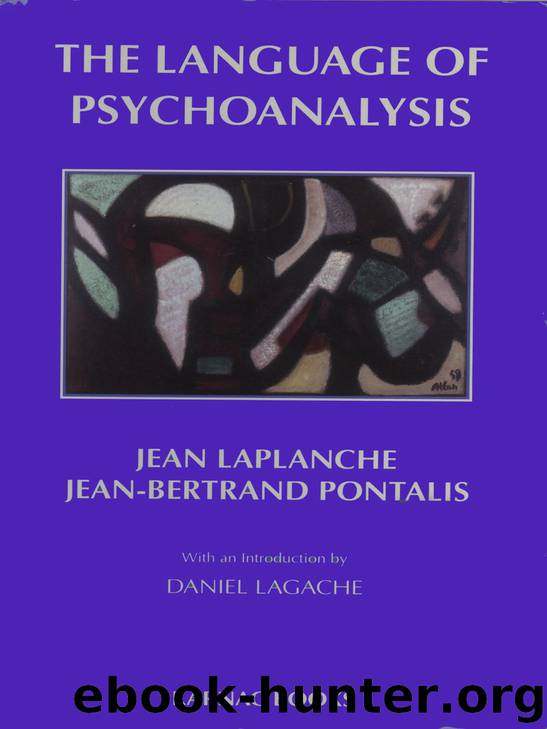The Language of Psychoanalysis by Laplanche Jean Pontalis Jean-Bertrand

Author:Laplanche, Jean, Pontalis, Jean-Bertrand
Language: eng
Format: epub
Publisher: Karnac Books
* * *
It is thus plain that the Freudian concept of the memory-trace is quite distinct from the empiricist notion of the engram, defined as an impression bearing a resemblance to the corresponding reality. In fact:
a. The memory-trace is invariably recorded in systems, and stands there in relation to other traces. Freud goes so far as to attempt to distinguish the different systems in which the traces of a single object are recorded, this according to the type of association involved (simultaneity, causality, etc.) (6, 7a). As far as evocation is concerned, a memory may be reactualised in one associative context while, in another, it will remain inaccessible to consciousness (see ‘Complex’).
b. Freud even tends to deny any sensory quality to memory-traces: ‘… if memories become conscious once more, they exhibit no sensory quality or a very slight one in comparison with perceptions’ (1b).
It might be supposed that the ‘Project for a Scientific Psychology’ (1950a [1895]), with its neurophysiological orientation, would furnish the best support for any assimilation of the memory-trace to the ‘simulacrum’-type image. In point of fact, however, this work provides instead the best point of access to what is most original in the Freudian theory of memory. In the ‘Project’, Freud attempts to account for the registration of the memory in the neuronal apparatus without making any appeal to a resemblance between trace and object. The memory-trace is simply a particular arrangement of facilitations*, so organised that one route is followed in preference to another. The functioning of memory in this way might be compared to what is known as ‘memory’ in the theory of cybernetic machines, which are built on the principle of binary oppositions, just as Freud’s neuronal apparatus is defined by its successive bifurcations.
It should be noted, nevertheless, that Freud’s way of referring to memory-traces in his later works–where he often also uses the term ‘mnemic image’ synonymously–does indicate that when he is not considering the process whereby they are constituted he is led to speak of them as reproductions of things in the sense in which this is understood by an empiricist psychology.
(1) FREUD, S. Beyond the Pleasure Principle (1920g), G.W., XIII, 24; S.E., XVIII, 25.
(2) BREUER, J. ‘Theoretical’ chapter of Studies on Hysteria (1895d), 1st German edn., 164n.; S.E.,II, 188–89n.
(3) Cf. FREUD, S. ‘A Note upon the “Mystic Writing-Pad”’ (1925a [1924]), G.W., XIV, 3–8; S.E., XIX, 227–32.
(4) Cf. FREUD, S., G.W., I, 295ff.; S.E., II, 291ff.
(5) FREUD, S. ‘The Neuro-Psychoses of Defence’ (1894a), G.W., I, 74; S.E., III, 60.
(6) Cf. FREUD, S. Anf., 186; S.E., I, 233–4.
(7) FREUD, S. The Interpretation of Dreams (1900a): a) Cf. G.W., II–I1I, 544; S.E., V, 538–9. b) G.W., Il–III, 545; S.E., V, 540.
Download
This site does not store any files on its server. We only index and link to content provided by other sites. Please contact the content providers to delete copyright contents if any and email us, we'll remove relevant links or contents immediately.
Rewire Your Anxious Brain by Catherine M. Pittman(17581)
Talking to Strangers by Malcolm Gladwell(11865)
The Art of Thinking Clearly by Rolf Dobelli(8836)
Mindhunter: Inside the FBI's Elite Serial Crime Unit by John E. Douglas & Mark Olshaker(7830)
Becoming Supernatural by Dr. Joe Dispenza(7100)
Change Your Questions, Change Your Life by Marilee Adams(6637)
Nudge - Improving Decisions about Health, Wealth, and Happiness by Thaler Sunstein(6629)
The Road Less Traveled by M. Scott Peck(6627)
The Lost Art of Listening by Michael P. Nichols(6465)
Enlightenment Now: The Case for Reason, Science, Humanism, and Progress by Steven Pinker(6404)
Win Bigly by Scott Adams(6306)
Mastermind: How to Think Like Sherlock Holmes by Maria Konnikova(6227)
The Way of Zen by Alan W. Watts(5790)
Daring Greatly by Brene Brown(5636)
Grit by Angela Duckworth(4729)
Big Magic: Creative Living Beyond Fear by Elizabeth Gilbert(4719)
Men In Love by Nancy Friday(4315)
Flow by Mihaly Csikszentmihalyi(4047)
The Four Tendencies by Gretchen Rubin(4018)
